How To Draw Image In Html5 Canvas
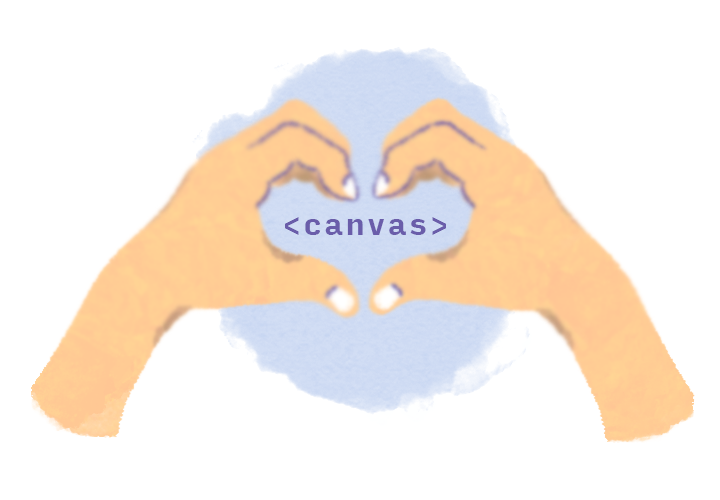
past Nash Vail
Ok, then here's a question: "Why do we demand an commodity for this, Nash?"
Well, grab a seat.
No wait! First, have a await at this.

Exactly. What was that?
drawImage is the method used to display or "describe" an image on canvas. You might or might not already know that information technology's non as uncomplicated as only passing the URI of the epitome to information technology. drawImage accepts a maximum of ix parameters. They go something similar this, set? Hold your breath…
(image, sx, sy, sWidth, sHeight, dx, dy, dWidth, dHeight) Breathe, out.
I found the documentation for drawImage a little confusing and hardcore. Just the documentation, yes. The concept and how the API works is neat for all the needs that it is supposed to serve.
We'll go over the parameters mentioned to a higher place one by ane, in a way that'll make consummate sense to yous. If at whatever point in the article you notice yourself going "I just wanted to draw an image on my canvas, dear Nash. Why put my mind through the ringer?", information technology'll exist an understandable frustration.
The way drawImage works does seem complex to some extent, just this complexity makes drawImage immensely powerful, and useful – as nosotros'll see through examples at the end. Moreover, the complication is but on the surface: once yous sympathise the whole moving-picture show it's a downhill bicycle ride on a land road somewhere in Europe.
By the end of this article you lot'll be able to visualise how drawImage will depict whatsoever given image on canvas just by looking at the values of the 9 parameters. Sounds similar a superpower you lot might wanna have? Okay then, let'due south dive right in!
Loading an image in canvas
Allow'southward offset elementary with an paradigm and an HTML5 canvas.
Here's what our directory looks similar
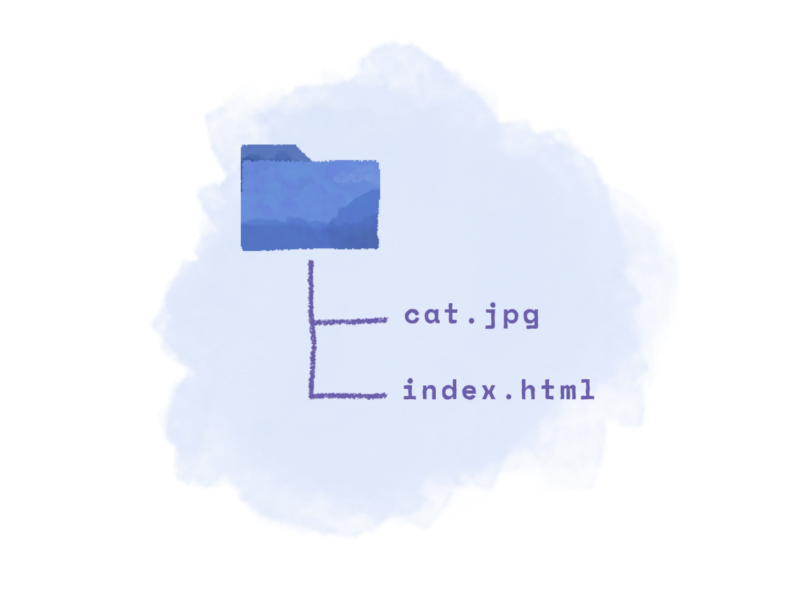
Inside of our index.html file we have created a new canvas chemical element similar then.
<canvas id="my-sail" width="400px" top="200px"/> Our goal is to take the true cat.jpg image and put it on the canvas (#my-canvas). And similar I already said, it ain't that easy betty! Otherwise I wouldn't exist writing this commodity, yous experience me? Good.
To start with, allow's target the sheet element using JavaScript and go its context.
const myCanvas = certificate.getElementById('my-canvas'); const myContext = myCanvas.getContext('2nd'); We need myContext to collaborate with the canvas element. It's like, if canvas is a bare sheet of paper, the canvas's context is the pen. Intuitively, y'all'll tell your pen to depict something on a blank sheet of paper, and not just yell at the paper to depict something on itself right?
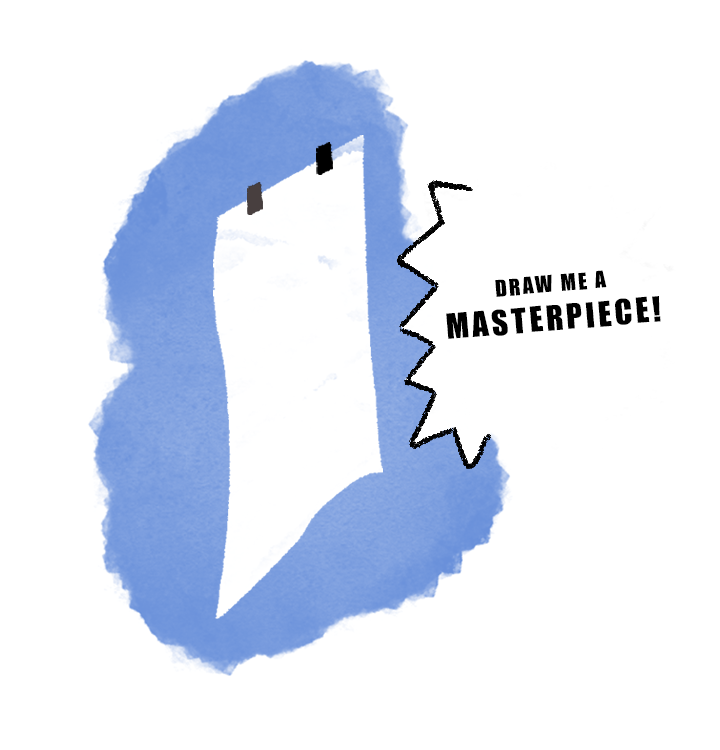
There are a number of things you lot can do with context. You can depict a rectangle, or an ellipse or a line, or an… image. Also, notice that the context myContext is implicitly linked to myCanvas. You lot tin can have multiple canvases and call getContext() on each of them to become a new context/pen for each. In our case we are dealing with just one canvas (myCanvas) and merely i context (myContext).
Alright, with that out of the way, nosotros tin can finally offset getting our feet moisture with drawImage.
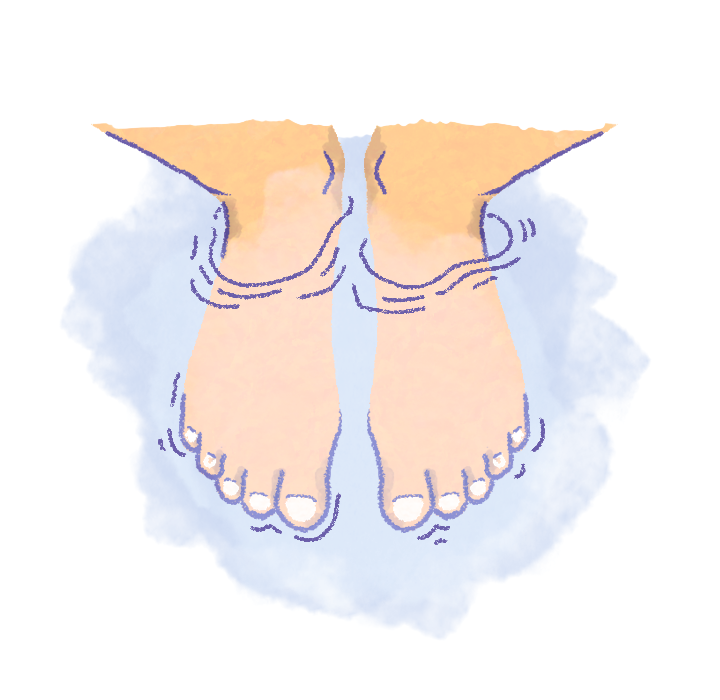
For a refresher, here are the 9 parameters that drawImage accepts.
(paradigm, sx, sy, sWidth, sHeight, dx, dy, dWidth, dHeight) We'll kickoff with the first parameter, image. Let's first write something that doesn't work.
context.drawImage('./cat.jpg', 0, 0); Come across the two zeroes at the end? Proficient. This is not the part of the commodity where you're supposed to understand what they're there for. Ignore them for now, just keep in the back of your head that Nash wrote two zeroes and didn't explain them. I won't mind.
At present notice ...('./cat.jpg',.. in the line of code above. Appears to be a perfectly correct URI doesn't it? And it is…buuuut, if you fire up index.html in a browser you'll see a long long mistake message identical to what's shown below.
Error: The provided value is not of type '(CSSImageValue or HTMLImageElement or SVGImageElement or HTMLVideoElement or HTMLCanvasElement or ImageBitmap or OffscreenCanvas) *gulp*
The mistake is telling us that it needs an image element and not just a URI to the prototype. To get around that, this is what we can do.
const canvas = document.getElementById('canvass'); const context = sheet.getContext('2d'); const img = new Prototype(); img.src = './cat.jpg'; img.onload = () => { context.drawImage(img, 0, 0); }; That is something you didn't await did you? Canvass needs a preloaded paradigm in social club to draw/display it in itself. No need to show any contempt towards canvas, by the way. Information technology has its reason, information technology's just like the rest of us. We'll eventually see what those reasons are and perchance then yous'll be able to empathize.

To epitomize:
drawImage asks for 9 parameters, first of which is prototype. We looked and understood that canvass requires a preloaded epitome to draw and not just a URI to the image. Why does information technology demand that? It will become articulate as you read.
Now it's fourth dimension for the remaning 8 parameters. Pop your collars! I am gonna learn you some graphics editing start!
How to crop a picture show
Every unmarried graphics editing program, even the nearly bones, comes with the characteristic of cropping. It's fairly unproblematic: open up an image > select the expanse you desire visible > hit ingather. And just like that, the naked beer belly of that obnoxious smelling former man is out. Poof!
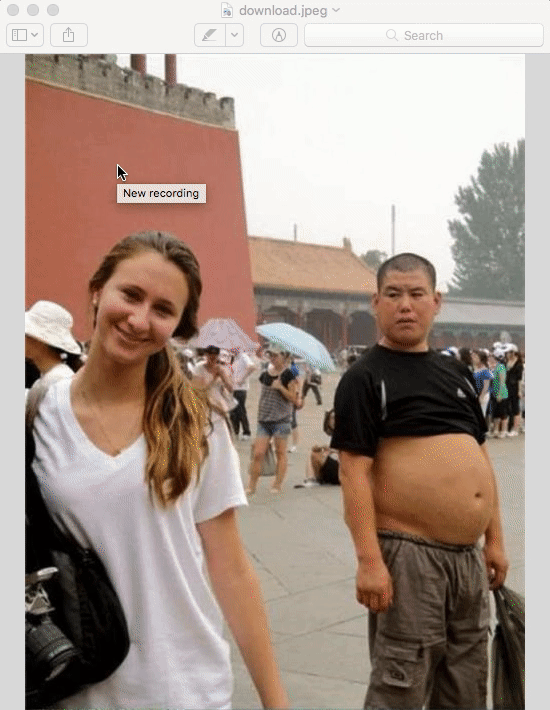
Technology! Saving people's Instagrams since Instagram existed.
Allow's take a step dorsum, and finish riiight, here.
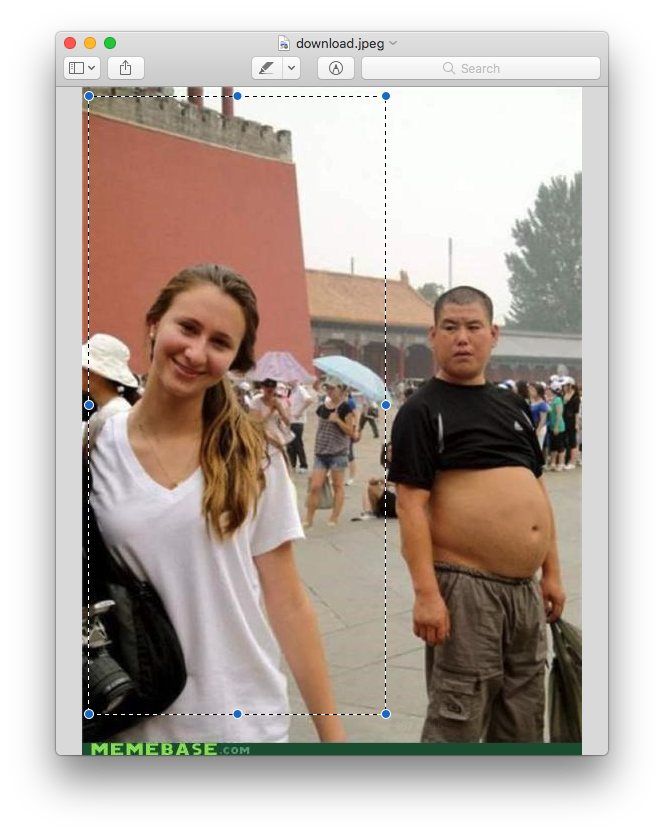
Permit's mark some points on it.
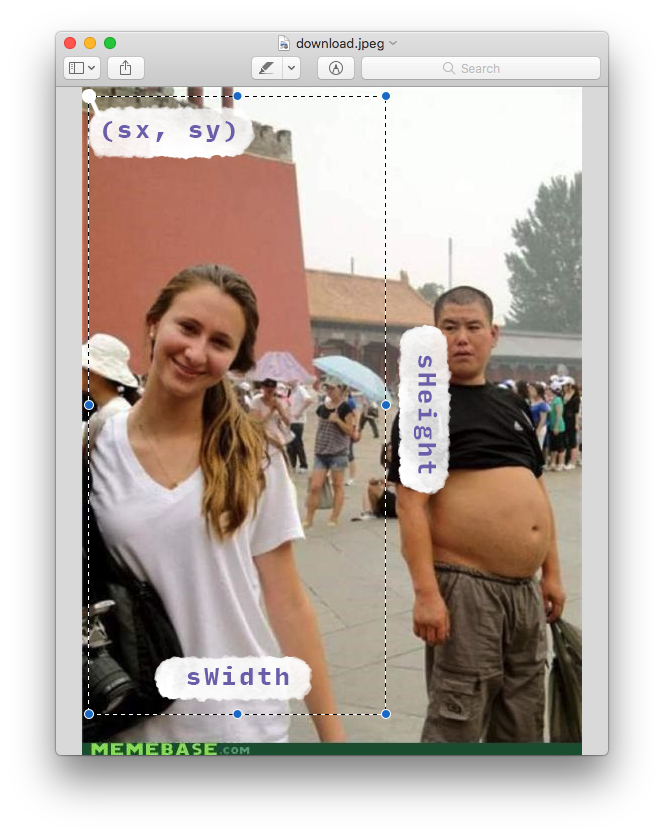
"Wait a 2nd! sx, sy, sWidth and sHeight? I have seen them before!"
Yes, about a infinitesimal agone! Which leads united states of america to the fleshiest part of the article.
Displaying an image on canvas, Step 1: Pick
The beginning task drawImage performs (backside the scenes) is it selects a portion of the paradigm based on the four s parameters (sx, sy, sWidth, sHeight). Y'all can say that s in all the s parameters stands for "select".
Hither's how it goes. sx and sy mark the point on the image from where the option is to brainstorm, or in other words the coordinates of the top left corner of the selection rectangle. sWidth and sHeight then, are the width and height of the option rectangle respectively. You tin can scroll right up to the last image to go a clearer moving picture of what I am trying to explain.
"Merely why the selection Nash? Can't it just display the unabridged image?" We're getting closer to all your answers, patience.
But know that the first pace drawImage performs later receiving a proper prototype is information technology selects a portion/area of the image based on the s parameters (sx, sy, sWidth, sHeight) you provide.
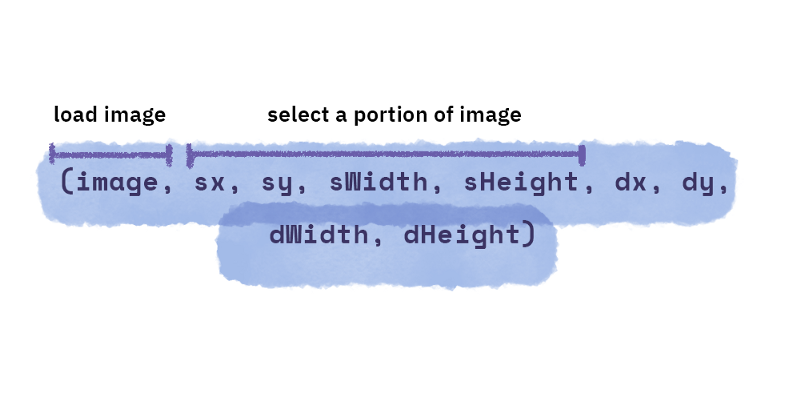
Recall that y'all don't e'er have to select a pocket-sized portion of the epitome, you can select the entire paradigm if you lot desire to. In that case sx and sy will take values 0 and 0 respectively and sWidth, sHeight will be the same as the image'south width and height.
Likewise, negative values are welcome for sx and sy. The values of sx and sy are relative to the origin of the image on the acme left.
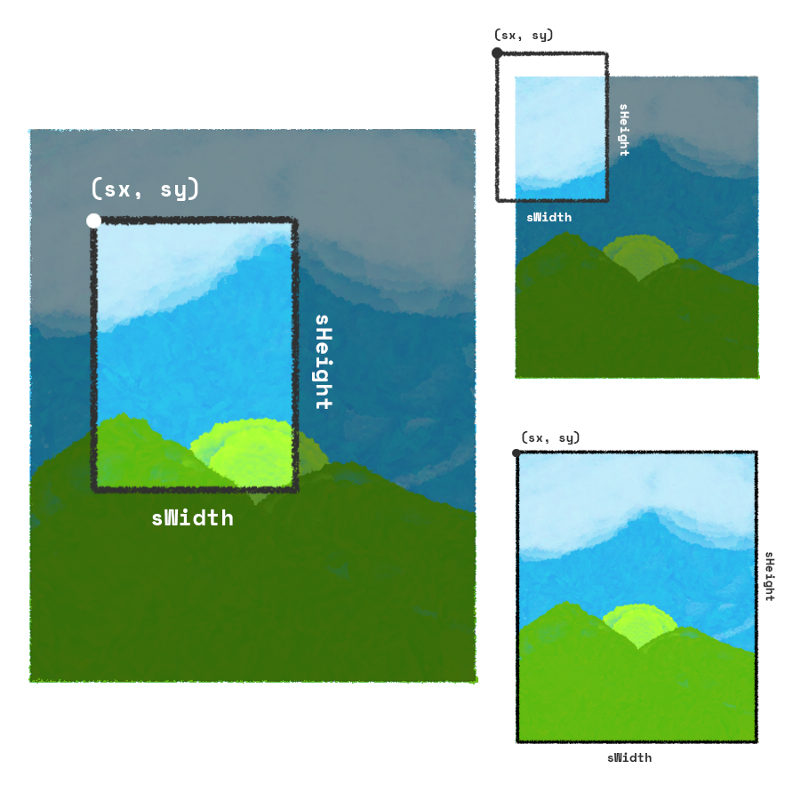
Once drawImage has selected the expanse of image you asked it to – and we'll see presently why selecting an expanse of the image helps – the next pace is to depict the selected portion of the image on the canvas.
"Originally" s and d in the official documentation represent 'source' and 'destination'. Only, just between us, let's phone call it 'select' and 'draw'. It makes much more sense this way, doesn't it?
Again. due southelection is done, the next footstep is to draw.
Displaying an prototype on canvas, Step 2: Drawing
To draw the selected portion of the image, we again need iv parameters.
- x Coordinate of where to get-go drawing on the canvas. (
dx) - y Coordinate of where to start drawing on the sail. (
dy) - How wide to depict the prototype. (
dWidth) - How high/alpine to draw the prototype. (
dHeight)
The values of dx and dy will exist relative to the origin of the sail.
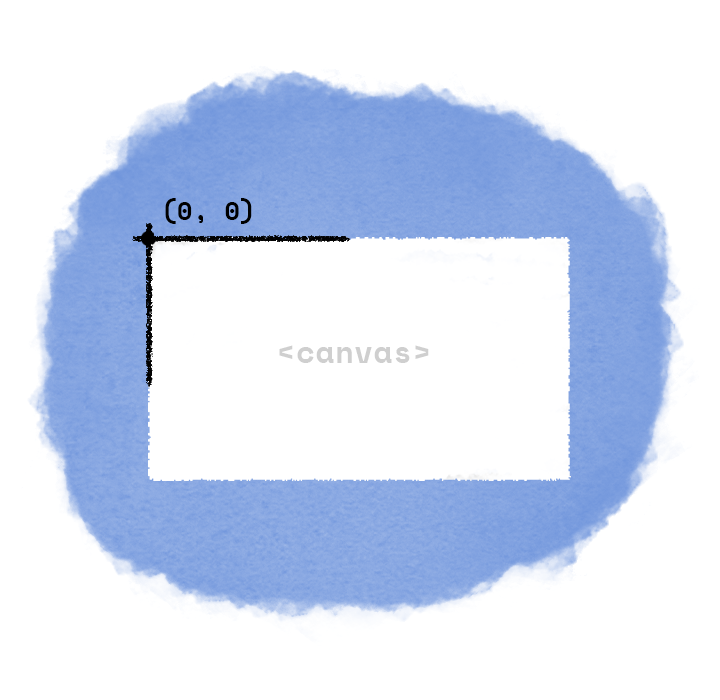
At that place's a very important simply subtle detail to notice here. dWidth and dHeight are in no mode tied to sWidth and sHeight. They are contained values. Why do you need to know that? Well, because if you don't choose values of the width and height of 'depict' advisedly you will end up with a stretched or squashed image, like this.
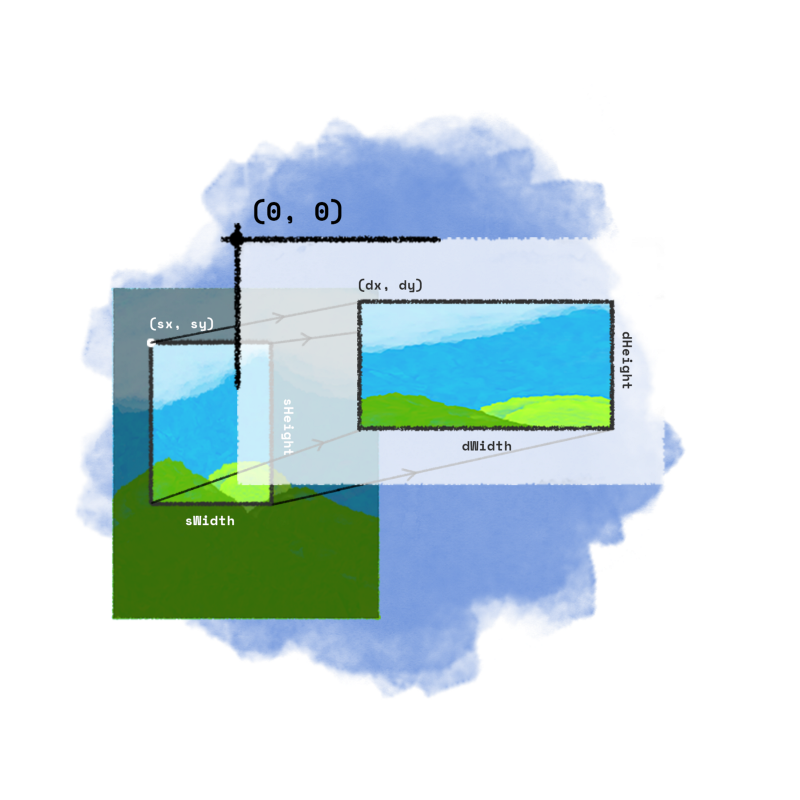
Then if that's something you lot're not looking for (which I hope you're non), make sure to maintain the attribute ratio. Or so to say sWidth divided by sHeight should exist equal to dWidth divided by dHeight. That was a pocket-size piffling disclaimer, you're the ruler of your ain globe and free to choose any values you lot like.
The whole procedure of displaying/drawing an image on sheet tin can thus be summarised in just 2 steps: Pick and Drawing.
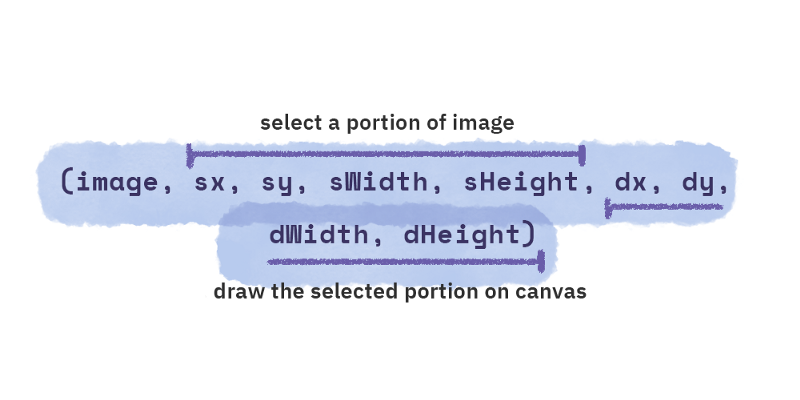
Awesome! Not so complicated later all is information technology?
Now at this betoken, we're done with all the theory. In rest of the commodity that follows we'll bake the concoction of knowledge spread effectually your head with a fun and practical example and yous'll be good to go. But, earlier we exercise that, let's talk virtually one terminal important thing apropos drawImage.
The default values
Recollect my lecture on "hey continue the aspect ratio and be careful don't take chocolates from strangers…"? Well, as it turns out, yous can omit certain values and not worry about the aspect ratio at all. As far as taking chocolates from strangers go, again — y'all're the ruler of your ain globe.
Here's one way to use the method.
drawImage(image, dx, dy) That is all! In this case, you're telling drawImage only the location on canvas where to start the drawing. The residuum, sx, sy, sWidth, sHeight, dWidth and dHeight are taken intendance of automagically. The method selects the entire paradigm (sx = 0, sy = 0, sWidth = image's width, sHeight = images' height) and starts drawing on canvas at (dx, dy) with dWidth and dHeight same as sWidth(prototype's width), sHeight(paradigm's height) .
Remember the two zeroes that I didn't explicate? That is where the two zeroes came from.
Yet another way to utilize the method is,
drawImage(prototype, dx, dy, dWidth, dHeight) In this form sx, sy, sWidth and sHeight are taken care of, and the method automatically selects the entire image and leaves information technology up to you to choose where and how large of an image to depict.
Pretty cool! isn't information technology?
If I tin can accept your attention for some other ii minutes I'd like to tell you why selection and drawing are two carve up operations. And how it is helpful.
Practise I have your attending? Nifty!
And then here.
Heard of sprites before? You lot see, sprites are a calculator graphics concept where a graphic may be moved on-screen and otherwise manipulated as a unmarried entity.
…?
I copied this definition from Google to sound suave.
Alright alright. Call back Mario?
Good.
Let'south do something fun.
Animating Mario with drawImage
You see, when Mario moves forward/astern or in any other management, it appears as if he is walking. His position changes merely also at that place is an accompanying animation of his legs and hands moving.
How exercise they do that? Do they show different images of Mario in succession, like a flipbook and it appears as if he's moving?
Well, fifty% yes. Imagine how resources intensive storing and loading a huge gear up of images describing every frame of animation in our program (or game) would be. Instead, there's a single image and all the positions are laid out in a filigree. Similar the ane shown below.
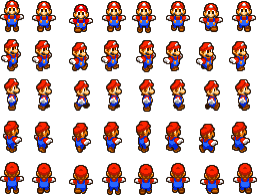
To execute an blitheness, instead of loading a new image every millisecond, a portion of the aforementioned image is shown through a viewport only at unlike positions. Clever isn't it?
So yeah, it'due south sorta like a flipbook, a clever flipbook really.
Now if you could but stretch a little and popular your duke I would similar us to recreate Mario's walking blitheness. Nosotros'll use the sprite shown above and everything we have learnt about drawImage and then far.
Set up? Hither we get!
Permit's take another look at our sprite and try to effigy the grid dimensions that it has been laid out on.
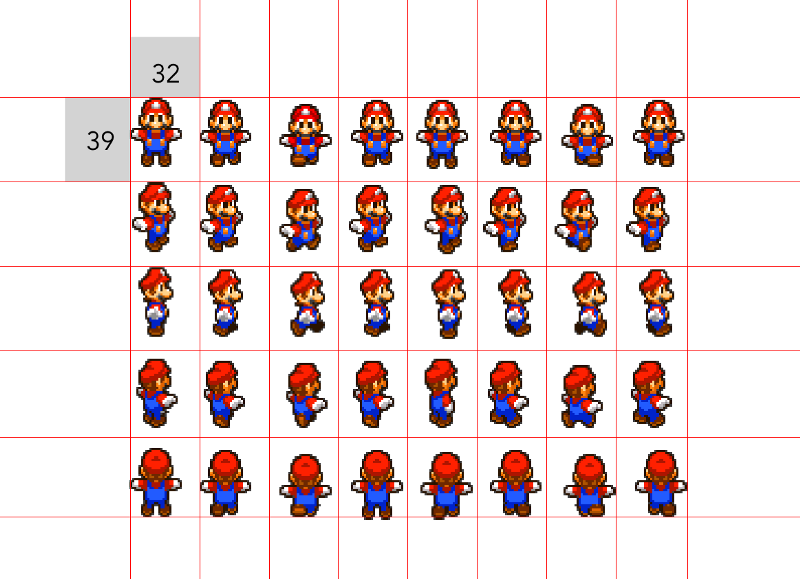
All that nosotros have done hither is imagined a grid over the sprite. Discover that the entire grid is made upwardly of cells of equal dimensions (32 x 39). But it's still just 1 image, remember that.
Smashing! Now allow's get to writing some lawmaking. We'll start in the usual way past showtime creating a canvass element, grabbing it and its context in JavaScript, and so loading our Mario spritesheet.
// index.js const sheet = certificate.getElementById('canvas'); const ctx = canvas.getContext('2d'); const img = new Image(); img.src = './mario.png'; img.onload = () => { ctx.drawImage(img, 0, 0); }; // style.css sheet { /*Add together a border around canvas for legibility*/ border: 1px solid grey; } The higher up code will result in the post-obit.
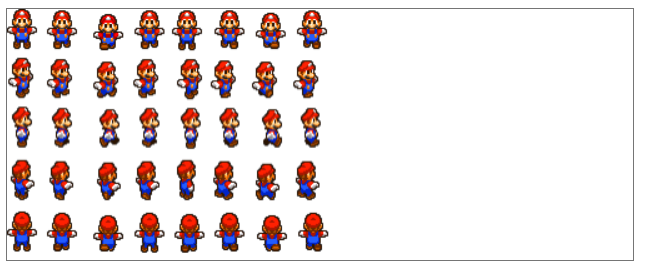
Woah-kay! We've got the image showing! What's happening actually?
Here, we're using the form of drawImage–drawImage(image, sx, sy)–where the whole image is southwardelected and drawn on the sail as it is.
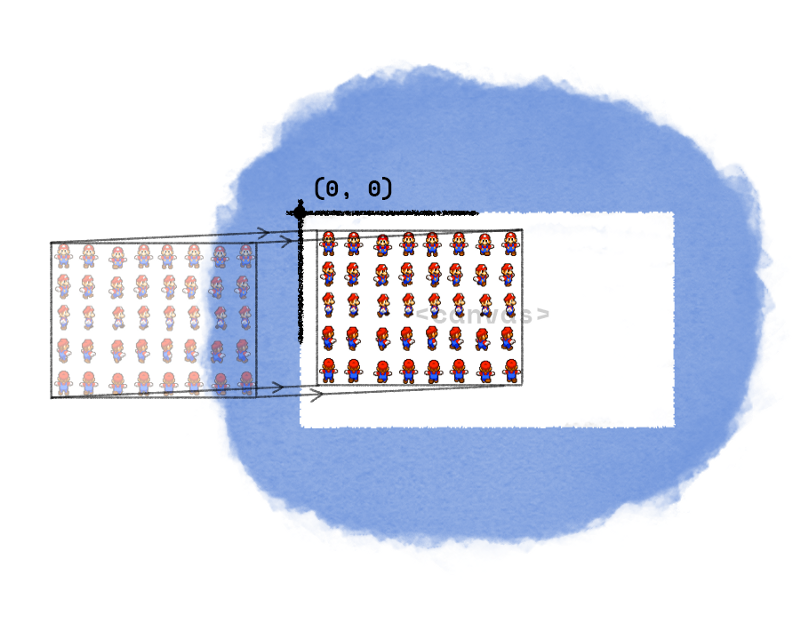
What we want to exercise, first of all, is select simply one prison cell of the filigree and depict just that single cell. Let'due south starting time out by showtime making tweaks to our code that selects the showtime prison cell in the third row, the ane in which Mario is continuing facing east. We'll figure how to animate once we have that done. Sounds adept? Lovely!
Permit'due south make the necessary changes to our code.
const canvas = document.getElementById('canvas'); const ctx = sheet.getContext('2nd'); // Mario variables const MARIO_WIDTH = 32; const MARIO_HEIGHT = 39; const mario = new Prototype(); mario.src = './mario.png'; mario.onload = () => { ctx.drawImage( // Image mario, // ---- Pick ---- 0, // sx MARIO_HEIGHT * 2, // sy MARIO_WIDTH, // sWidth MARIO_HEIGHT, // sHeight // ---- Drawing ---- 0, // dx 0, // dy MARIO_WIDTH, // dWidth MARIO_HEIGHT // dHeight ); }; Beginning off, notice the two variables MARIO_WIDTH and MARIO_HEIGHT. They are the dimensions of the filigree cell, that'due south all they are. We defined them to make information technology easier for us to traverse the grid using just multiples of each of those constants. Makes sense?
Good.
Next, in the // Selection block we defined the area of the image we want to select, in the // Drawing section we defined the width and height and the position from where to starting time cartoon on the canvas… aaand just like that we managed to draw just one cell of the entire imaginary filigree.
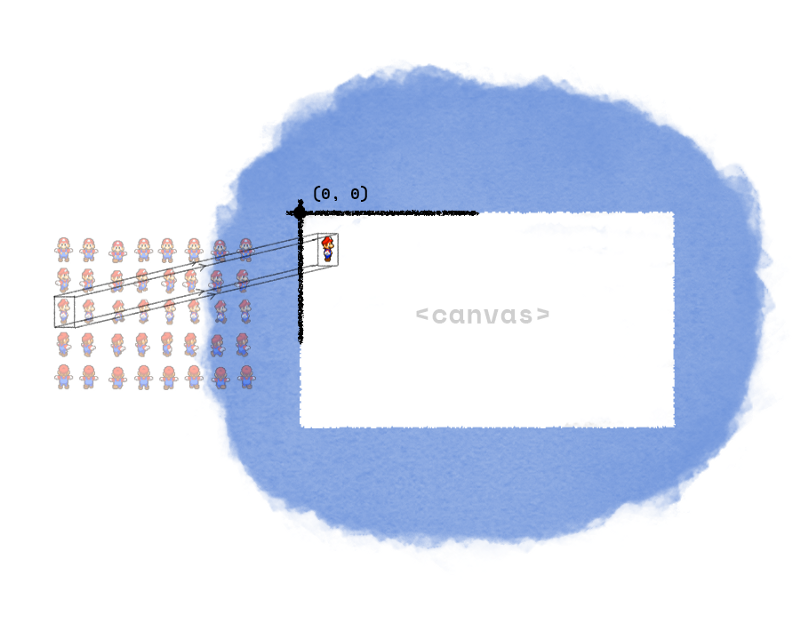
Pretty elementary, just choice and drawing. At present at this point I'd like to digress into an older topic near attribute ratio. "Nash! again? ugghh" I know I know. But it'southward cool! Look!
If I change the values of dWidth or dHeight or both of them, expect at how the paradigm stretches and squashes.
... ctx.drawImage( // Image mario, // ---- Selection ---- 0, // sx MARIO_HEIGHT * 2, // sy MARIO_WIDTH, // sWidth MARIO_HEIGHT, // sHeight // ---- Drawing ---- 0, // dx 0, // dy MARIO_WIDTH * ii, // dWidth MARIO_HEIGHT * 1.5 // dHeight ); ... 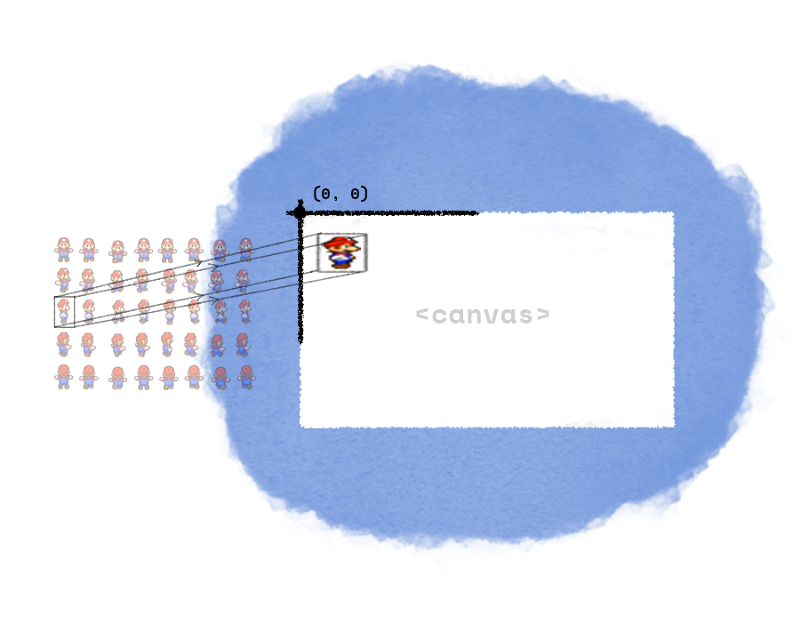
Hah! Run into! That's why I was advising yous to maintain the attribute ratio and that the values of selection and drawing have no real interconnection.
Okay, back to what nosotros were doing.
So now we accept Mario in the sail, minor and little. We need to breathing it, or in other words show different frames at the same location in succession and make the illusion of move happen. Was I too specific? Heck yeah!
We can do that by selecting the filigree cells we want to describe in succession. We just need to change the value of sx by the multiples of MARIO_WIDTH.
Now doing this will crave the use of requestAnimationFrame and I have been explaining that in a streak in this article and this article.
Equally a pocket-sized challenge why don't you become ahead and try accomplishing this on your own? In any case, y'all can check out this Codepen where I take Mario running like this. The pen has enough comments to aid you understand the tiny bit of high school math that's being used to make the animation happen.
Beautiful little matter!
And with that, we're done with a very comprehensive explanation of drawImage. Hope you enjoyed.
If you accept fabricated it this far, how nigh you shoot me some feedback or #goodvibes on Twitter?
This article was originally published on www.nashvail.me.
Did I tell you about my new website? And did I tell yous it has a Newsletter likewise? I'd love if y'all subscribed so I can notify y'all each fourth dimension I publish something new or put something new for auction in my shop. I'll continue publishing articles on Medium but there'll exist a two-week gap between when it beginning goes up on my site and when it shows upwards hither.
Thanks so much for reading and thank you so much for your support. Have a expert ane! :)
Learn to code for free. freeCodeCamp'due south open up source curriculum has helped more than xl,000 people get jobs every bit developers. Get started
Source: https://www.freecodecamp.org/news/how-displaying-an-image-on-html5-canvas-works-13e3f6a6c4bd/
Posted by: engelhardtbusert.blogspot.com


0 Response to "How To Draw Image In Html5 Canvas"
Post a Comment